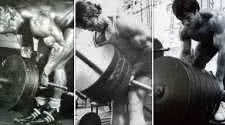T-Bar Rows: Proper Exercise Form for T-Bar Rows for Back Muscles

There are Many Variations of T-Bar Rows for Success
Did you know there is an exercise that will add both width and depth to your biggest and most impressive upper-body muscle group, your back? It is
true - such an animal really does exist and it is very effective. Most back- training exercises fall into one of these two major categories:
width-producing movements (such as chin-ups and lat pulldowns) and depth-producing movements (bent rowing, dumbbell rowing, cable rowing, etc.).
Most good training programs will distinguish between the two and correctly provide specific training exercises for each. There is, however, one super
fantastic exercise that serves both of these purposes at once.
The exercise is the T-bar row, made popular by Mr. Schwarzenegger. Some may point out that T-bar rows are primarily a depth movement, and they
would certainly be correct. However, a variation of the T-bar is both depth- and width-building, wrapped up in one neat motion. That variation is
the one-arm T-bar row.
The one-arm T-bar lift utilizes a single-hand grip, instead of both hands, to pull the T-bar up. This single-hand grip allows for a much longer
stretch of the lat area. A good stretch promotes quicker growth, especially when it also involves lifting a heavy weight at the same time. The stretching
potential of the one-arm T-bar row is much greater than for either the bent row or the regular two- handed T-bar row. The one-arm T-bar row also allows
the body to be braced with the free hand, and that takes some of the undue pressure off the lower back and spine area, where many trainers have major
problems with beat-over rowing. The one-arm T-bar's combination of a deeper stretch with a better body brace is dynamite!
Another plus is the extreme focus that can be dedicated to the one-arm T-bar lift. Bent over dumbbell rowing also allows for a great deal of
lat-stretching, but a lifter can handle a lot heavier weight with the one-arm T-bar row. Therefore, the growth potential is much greater. The one-arm
T-bar row is perhaps the finest single exercise of all possible hack-development movements.
Grasp the weight with one hand. Instead of putting both feet at the usual spot as with the regular T-bar row, place the inside foot - the one nearest
the bar - back at an angle and brace the free hand on the knee of the outside leg, which is slightly bent. Pull the bar upward as far as you can, with
the elbow coming back and out as far as possible. Lower the bar all the way down, halting the upper body and letting the back muscles be pulled and
stretched out by the descending weight.
Be careful for the first couple of workouts. Get used to the motion. Don't pull a muscle the wrong way. The stretch on this movement is about as
extreme as it gets. Once you are used to the weight you can really get working, but always keep your movements slow and smooth. After the first few
workouts load the bar up and watch as your back puts on some impressive muscle size. Go with a high repetition count and a heavy load.
Try out the terrific one-arm T-bar row. You will be amazed at the improvements on your back. Build both depth and width in one shot with the totally
nasty T-bar row - one arm at a time.